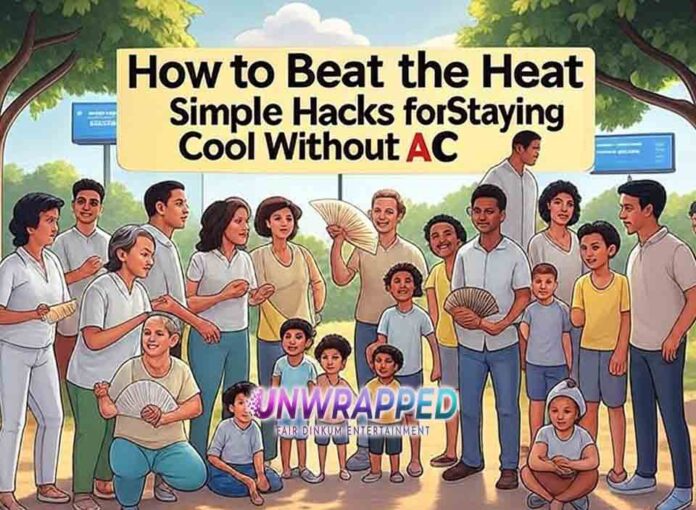As global temperatures continue to soar, keeping cool during the hot summer months has become more than just a matter of comfort—it’s about safety and survival. For many people, air conditioning isn’t always an option, whether due to cost, environmental impact, or simply lack of access. That’s why learning how to stay cool without AC is more relevant than ever.
From low-tech tricks to natural ventilation strategies, beating the heat doesn’t require a power-hungry machine. This article breaks down practical, proven ways to stay cool, drawn from science, tradition, and expert advice—ensuring relief is possible even during a scorching heatwave.
Create a Cool Microclimate Indoors
Block Out the Heat
The sun is your biggest enemy during a heatwave. Close curtains, blinds, or use blackout drapes to block solar radiation. Reflective window films and thermal shades also reduce heat gain. According to the U.S. Department of Energy, white or reflective window coverings can cut heat gain by up to 33%.
Cross-Ventilation Works Wonders
Open windows on opposite sides of the house in the early morning or late evening when outdoor temps are lower. This promotes natural airflow, especially if enhanced with fans pointing outwards in one direction and inwards on the other.
Switch to Natural Fibers
Ditch synthetic bed sheets and clothes. Opt for cotton or linen, which are breathable and moisture-wicking. These materials help regulate body temperature more effectively than polyester or nylon.
Create a DIY Cool Room
Designate one room in your home as a “cool zone.” Insulate it as best as possible, seal off unused rooms, and use fans or coolers to concentrate your efforts. Placing a bowl of ice in front of a fan can mimic a mini air conditioner by blowing chilled air around.
See Also: Best Ways to Clean Aircon Filters at Home
Optimize Fans Like a Pro
Use Fans Strategically
Fans don’t cool air; they move it. That said, they can enhance evaporative cooling and assist in ventilation. Point box fans toward open windows in the evening to push hot air out.
Set Ceiling Fans to Rotate Counterclockwise
Many people overlook this: ceiling fans have a summer and winter mode. In summer, they should rotate counterclockwise to push cooler air downward.
Harness the Power of Exhaust Fans
Kitchen and bathroom fans pull hot, humid air out of your home. Use them during and after cooking or showering to reduce indoor humidity and heat levels.
Try the Ice-Fan Combo
Place a shallow pan filled with ice or a frozen water bottle in front of a fan. The breeze picks up the cold moisture as the ice melts, simulating a DIY AC.
Stay Hydrated and Regulate Your Body Temperature
Drink Smart
Water is essential, but adding electrolytes can improve hydration. Try drinks with natural salts or make homemade electrolyte water with salt, lemon, and honey. The CDC recommends drinking more water than usual during heat waves and avoiding alcohol and caffeine.
Use Cooling Towels or Bandanas
Wet a washcloth or cooling towel and place it around your neck, on your wrists, or forehead. These areas have major blood vessels close to the skin, helping cool you faster.
Take Lukewarm (Not Cold) Showers
A lukewarm shower helps your body naturally release heat. Ice-cold showers may cause your body to retain heat internally by constricting blood vessels.
Eat Light, Eat Right
Heavy meals increase metabolic heat. Stick with hydrating, light foods like cucumbers, melons, yogurt, and leafy greens. Spicy foods may seem counterintuitive, but they trigger sweating and help cool the body faster.
Keep Appliances and Lights in Check
Unplug Heat-Producing Devices
Electronics and appliances emit heat even when not in use. Unplug devices or switch to energy-efficient alternatives. Cook outdoors or use a microwave instead of your stove.
Switch to LED Bulbs
Traditional incandescent bulbs convert 90% of energy into heat. LEDs stay cooler and save on energy bills. As per Energy.gov, LED lighting can reduce heat output in your home.
Avoid Daytime Laundry and Cooking
Use appliances like dryers and ovens during early morning or evening hours to prevent unnecessary indoor heat during the peak daytime.
Cool Your Sleep Setup
Freeze Your Bedding
Place your pillowcases or sheets in a plastic bag and put them in the freezer for an hour before bedtime. It won’t last all night, but it gives immediate relief.
Sleep Low
Heat rises. Sleep on a lower floor, or even on the floor itself on a bamboo mat or cotton blanket to benefit from cooler air near the ground.
Try a Buckwheat Pillow
Unlike foam pillows, buckwheat pillows allow airflow and don’t retain body heat. Many natural wellness experts recommend them for hot sleepers.
Use a Fan Under the Bed
Prop your mattress up slightly or use a thin sleeping mat. A fan underneath can circulate air around your body while you sleep, offering continuous cooling.
People Also Love: The Advantages of High Horsepower Aircon Systems What You Need to Know
Use Nature to Your Advantage
Plant Shade Wisely
Trees and climbing plants can block sun rays from hitting your walls and windows. Vines, shrubs, and window boxes not only add beauty but serve as natural cooling agents. According to the EPA, strategic landscaping can reduce nearby air temperatures by up to 9°F.
Embrace Indoor Plants
Plants like aloe vera, snake plant, and peace lilies can purify and slightly cool the air by releasing moisture through transpiration.
Cool Down with Water Features
If you have a balcony, patio, or backyard, misting systems, fountains, or even kiddie pools can cool ambient temperatures. The evaporative cooling effect is a natural and soothing way to lower heat.
Call-to-Action: Stay Cool, Stay Safe
Beating the heat doesn’t require expensive technology—just a few clever shifts in how we live, eat, and sleep. If you found these cooling hacks helpful, share this guide with someone braving the summer heat or subscribe for more seasonal wellness and survival tips.
Your comfort matters, and your creativity could be your biggest ally this summer.
Conclusion
Extreme summer heat isn’t just uncomfortable; it can be dangerous. But with the right knowledge and techniques, anyone can transform a sweltering home into a haven of relief. Small changes like optimizing airflow, adjusting diet, and embracing natural cooling techniques can go a long way in keeping the body temperature in check.
Ultimately, staying cool without air conditioning is possible. These tips not only reduce reliance on electricity but also help you live more sustainably while keeping your health and well-being front and center.
Another Must-Read: Healthy BBQ Hacks: Leaner Cuts and Smarter Cooking Methods










